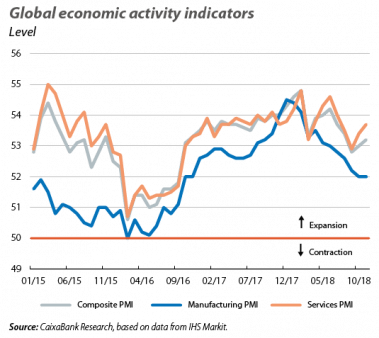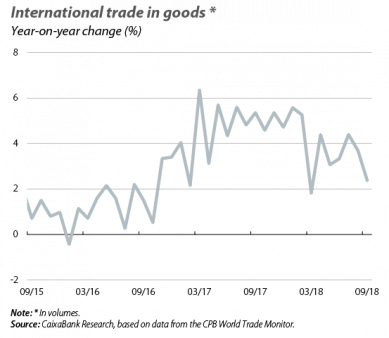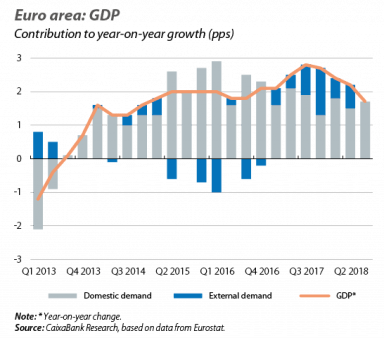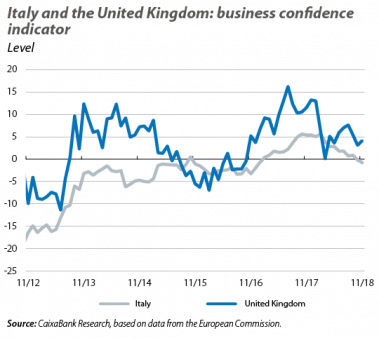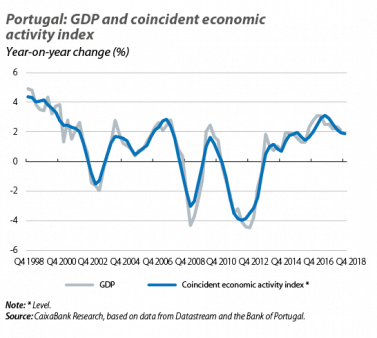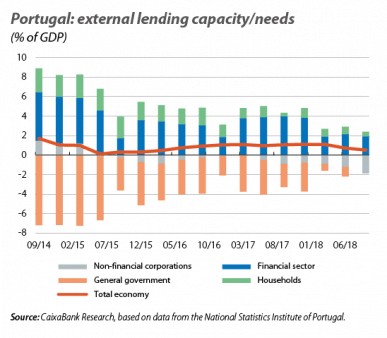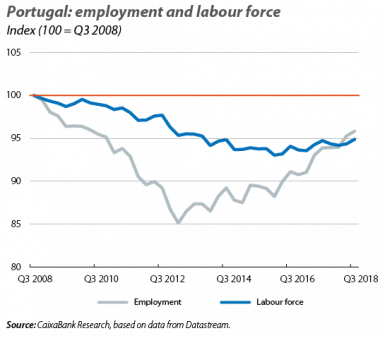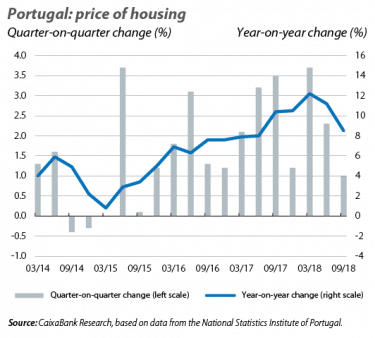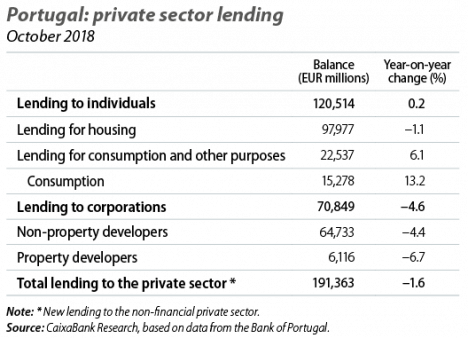Economic activity slows down, but the trend could be temporary
A temporary pause in the global slowdown? Following a few difficult quarters with declining momentum in the global economic sentiment indicators, the latest available data show that some representative confidence indicators, such as the global composite PMI, have rebounded. A similar reading can be drawn from economic activity indicators in the emerging markets, such as the so-called IIF Growth Tracker, which seeks to estimate these countries’ contemporary growth and which registered two consecutive months of increases in November. Besides this representing a pause in the economic slowdown, the length of which remains to be seen, the global indicators still suggest a slower pace of economic activity compared to a few quarters ago. Furthermore, if we review the factors that lie behind this moderation, the indicators suggest that the slowdown observed over the past year seems likely to continue.
The factors hindering growth remain active. The slowdown in the global economy witnessed in recent quarters has been brought about by a combination of factors that are acting simultaneously and which are expected to continue to (moderately) restrict global growth in the near future. Firstly, the global financial conditions have become less accommodative due to the measures of certain central banks (mainly the Fed’s normalisation of monetary policy, as is well known), as well as due to the surge in financial volatility in many stock markets and, in some cases, sovereign debt yields. In addition, geopolitical uncertainty (particularly the rise of US protectionism, which has led to a spiral of trade tensions with China and, to a lesser extent, with the EU) is already taking a toll on international trade flows. As such, in September, year-on-year trade growth stood at 2.4%, compared to 5.6% at the beginning of 2018. Finally, the trend in commodity prices, not only oil but in a broader sense, has experienced a downturn in the second half of the year: the CRB index, which measures a wide range of commodity prices, has fallen by 7% since last June. Given that this is a key source of growth for many emerging markets, it is logical that they are losing momentum.
Economic activity slows down, but the trend could be temporary. The latest economic activity indicators for the euro area suggest that the economic slowdown continues, which has increased concerns over the actual rate of growth that can be expected over the coming quarters. All in all, the breakdown of GDP for Q3 2018 confirmed that domestic demand remains the main driver of growth in the euro area. Given the inertia that this component generally has, this leads us to think that the growth of the euro area will reach healthier levels over the next few quarters (for more details, see the Focus «Euro area growth: neither very fast nor particularly slow» in this Monthly Report). This is also the ECB’s reading, which highlights the temporary nature of the current slowdown and is being accepted as a consensual and reasonable view.
The United Kingdom and Italy remain sources of uncertainty. As the official date of the United Kingdom’s departure from the EU approaches, certainty over how the process will be carried out is decreasing, rather than increasing. In December, we witnessed the withdrawal of the parliamentary vote on the preliminary Brexit agreement and a motion of no confidence in Theresa May, which, eventhough she survived it, also served to confirm the fragmentation within the Conservative Party itself. A new attempt at ratifying the preliminary agreement in the House of Commons has now been announced and is due to take place before 21 January 2019. Although the British Government is expected to ratify the agreement, the difficulties in achieving a majority in the House of Commons increase the chances of the United Kingdom deferring its departure from the EU, or of the day of Brexit arriving without an agreement having been reached, which would lead to a disorderly exit for the United Kingdom. Developments in the budgetary conflict between Italy and the EU, on the other hand, are somewhat more positive. After the European Commission kick-started the process to implement a so-called «excessive deficit procedure» against Italy, the Italian Government has conceded and has announced a downward revision of its deficit target for 2019 (2.04% of GDP, compared to the 2.4% initially proposed). Despite this representing a step in the right direction and the European Commission announcing that the procedure could be called off, Italy’s public finances are unlikely to cease being a source of risk.
Portugal: consolidation of the expansive phase
Solid growth in a more mature phase of the cycle. While we await the latest data of the year, all the indicators suggest that in 2018 as a whole, the Portuguese economy will have grown by slightly more than 2%. This implies a certain deceleration compared to the 2.8% of 2017 and reflects a natural moderation of growth as the economy enters a more mature phase of the cycle (in addition to reflecting the effect of the slowdown of the major neighbouring economies, which is particularly felt by small open economies such as Portugal). As such, this trend is expected to continue in 2019, with a growth rate close to but slightly below 2%. However, the Portuguese economy enters this phase of the cycle strengthened by the improved competitiveness it has achieved in recent years. This is reflected in the latest update of the global competitiveness index prepared by the World Economic Forum, in which Portugal has climbed eight positions compared to last year, reaching 34th out of a total of 140 countries. Furthermore, Portugal has made progress in practically all areas of the index, especially those related to the skills of the workforce, the capacity for innovation and the labour market. Nevertheless, these positive prospects for the economy in the medium term are not exempt from risks, particularly in view of the fear of a less favourable external environment, which is discussed in the International Economy section in this same Monthly Report.
External financing capacity tempers. In particular, in Q3 2018 Portugal’s external financing capacity stood at 0.5% of GDP, slightly below the 0.7% registered in Q2 and the average for 2017 (1.0%). This moderation was primarily due to the increase in the financing needs of non-financial corporations (which went from –1.2% to –1.9%) as a result of the sector’s higher levels of investment, as reflected in its healthy gross fixed capital formation figures (+5.7%). On the other hand, the reduction in the external financing capacity of households (from 0.8% in Q2 to 0.4% in Q3), with private consumption increasing faster than disposable income (and keeping the savings rate low, at around 4%), also weighed down the financing capacity of the economy as a whole.
A positive trend in the public accounts. According to the latest data from the national accounts, the budgetary balance of the public sector stood at +0.7% of GDP in Q3 2018. This encouraging figure reflects the positive trend in the public accounts in recent years, favoured by the economic cycle and the labour market. In this regard, revenues registered significant growth (5.4%), while the trend in expenditure was also encouraging with an increase of just 0.8% (excluding base effects related to the restructuring costs of the financial system). After adjusting these figures for the changes in how the Christmas wage was paid to public sector employees and pensioners (see the Portuguese Economy section of the MR12/2018), the figures reinforce the forecast that the government balance will have ended the year at around –0.7% of GDP.
The labour market consolidates its recovery. Since employment reached a low point in early 2013 as a result of the 2008 international financial crisis and the recession that followed, Portugal’s economy has created nearly 548,200 jobs in net terms and total employment is approaching the levels registered before the crisis. At the same time, the composition of job creation has been realigned over the course of 2018, with jobs associated with the public sector and manufacturing gaining weight, to the detriment of sectors associated with tourism. This recovery in the labour market continues to be reflected in the latest data, which show that in October employment increased by 1.7% year-on-year (seasonally adjusted) and the unemployment rate stood at 6.7%, the lowest level since the end of 2002.
Housing price growth moderates in Q3. In particular, the transaction-based house price index increased by 8.5% year-on-year in Q3, 2.7 pps less than in Q2, making it the second consecutive quarter with a slowdown in growth. By segment, the prices of existing homes rose by 9.2%, while those of new homes rose by 5.7%. In addition, in quarter-on-quarter terms, the price of housing grew by 1.0% in Q3 2018, its lowest rate in the past three years. Over the coming quarters, the slowdown in housing prices is expected to gradually continue. This is due to the moderation in tourist activity and the slowdown in global economic activity, forces that have contributed particularly to the buoyancy of real estate prices in recent years.
New bank lending remains strong. In October, the total balance of new lending to private individuals rose for the third consecutive month (+0.2%), something not seen since 2011. As for lending to corporations, new lending rose by 13.5%, but in net terms the stock of credit fell by 4.6% due to sales of credit portfolios. Despite these positive trends, the environment is not without risks. In this regard, in its December Financial Stability Report, the Bank of Portugal highlights the sudden surge in risk premiums (which causes a reduction in the value of assets – particularly relevant given the banking sector’s exposure to public debt securities) as one of the risks to the country’s financial stability over the coming quarters.
